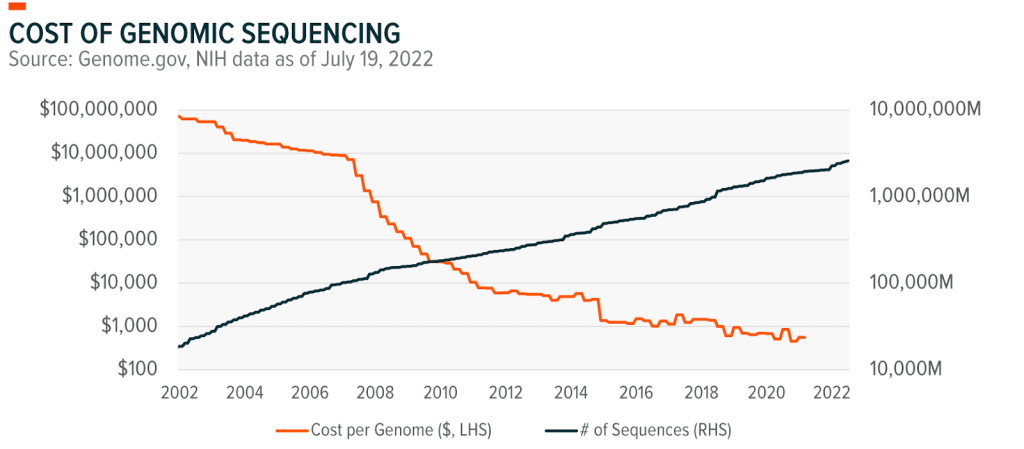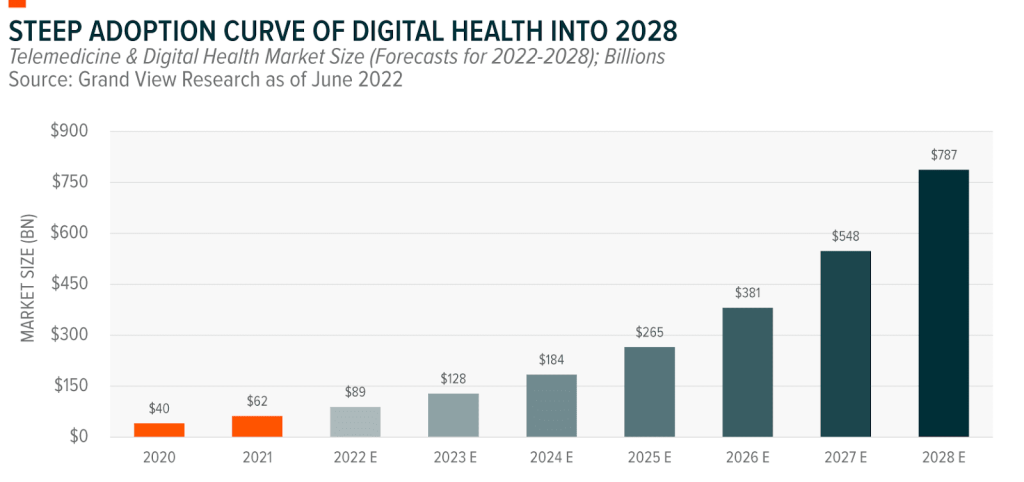By Shannon Ahern and Jon Maier
Here’s a heartening piece of news: We’re living longer! Back in 1950, the world’s average life expectancy was roughly 46.5 years. By 2022, it was 71.1 However, longer life expectancy comes with economic challenges, as the cost of aging is real. In the United States, adults over the age of 65 account for 40–50% of healthcare spending, and their per capital healthcare costs are 3–5x higher than those under 65. At the federal level, the Congressional Budget Office (CBO) estimates that U.S. government spending on healthcare will rise from 5.4% of GDP in 2017 to 6.8% by 2028 and 8.4% by 2040.2
Healthcare spending will look different than in the past, with healthcare innovation booming and improving diagnoses, treatments, and quality of life. From the wonders of genomics to the convenience of telemedicine and the potential that artificial intelligence (AI) holds for these two segments, healthcare is in transition, and in our view, creating compelling opportunities for investors.
Key Takeaways:
- Genomic sequencing increases understanding of disease inheritance, how disease is transmitted, and how to work towards a cure. Using genomics to diagnose diseases early, even before symptoms present, can increase chances of successful treatments.
- The healthcare system is increasingly digital, with telemedicine playing a major role. After demonstrating its utility during the pandemic, telemedicine is poised for sustainable growth as it increases healthcare access and affordability.
- AI is integral to the advancement of genomics and telemedicine, as it can fast-track diagnoses and treatments and expedite patient care. And as it does, we expect it to help investment opportunities can continue to emerge across the Healthcare Innovation investment theme.
Genomics Personalizes Medicine
Genomics enables deeper insights into our DNA. Critically, access to genomics technology is growing as it becomes more affordable. As the chart shows, the cost of genomic sequencing, the process by which scientists identify genetic mutations in unhealthy cells, has plunged from a hefty $100 million per genome in 2002 to less than $600 in 2022, with further reductions expected.3

The genomic sequencing market is projected to reach $24.5 billion by 2030, with a compound annual growth rate (CAGR) of 16.1% from 2022 to 2030.4 Helping this growth is next-generation sequencing (NGS), a process that extracts a sample DNA, fragments it into pieces, and attaches those pieces to small readers that are inserted into a sequencing machine. Specialized software then identifies genetic variants, gene expression patterns, and other features of interest in each piece. NGS is technology that facilitates genetically targeted drugs, early cancer detection, and prenatal genetic screening.
Pharmacogenomics tailor treatments to an individual’s genetic profile, which can enhance their effectiveness while reducing side effects. The global personalized medicine market is set to grow at a CAGR of 6.93% to $923 billion by 2030.5 Gene therapy is another frontier aiming to treat or cure diseases by correcting the underlying problems in an individual’s DNA. This technique has the potential to treat a spectrum of diseases like cancer, cystic fibrosis, diabetes, and HIV.
Telemedicine Connects the Patient
The number of medical visits conducted through telemedicine grew from 840,000 in 2019 to 52.7 million in 2020, accelerated by the pandemic.6 Telemedicine visits have stabilized since, but they are increasingly standard practice, and the telemedicine and digital health market is expected to reach $787 billion by 2028, a 43.7% CAGR from 2020.7
Telemedicine bridges the gap between facility-based treatment and at-home care, offering value-added services like pharmacy delivery and in-home lab testing. This technology is especially valuable for elderly and remote patients.
Despite the slowdown in usage post-pandemic, the global telemedicine and digital health market is still expected to grow from $40 billion in 2020 to nearly $790 billion by 2028.8 Helping this growth in the U.S. is the Consolidated Appropriations Act of 2023, which secured continued telehealth benefits for patients, including for mental health care.

AI Supercharges Diagnosis and Treatment
Valued at $15.4 billion in 2022, according to a recent report the global market for AI in healthcare can grow at a CAGR of 37.5% from 2023 to 2030. Government support, an active M&A environment, and lessons learned during the pandemic are among the drivers fueling the integration of AI in healthcare.9
Machine learning algorithms can process massive amounts of data quickly and accurately, which can accelerate diagnosis, support image recognition, and personalize treatment plans. The technology is now a standard tool in identifying disease-associated genes and understanding the role of genetic mutations in health conditions.
In telemedicine, AI powered chatbots, remote monitoring systems, and continuous monitoring of chronic conditions. Patients can seamlessly access medical care while benefiting from personalized treatments based on AI-driven tools.
Conclusion: As Healthcare Innovates, Investment Opportunities Emerge
If the world’s population continues to age at its current pace, 82 might be the average number of candles on our birthday cakes by 2100.10 The associated economics of this demographic shift makes the development of new healthcare technology critical. Genomics is the gateway to personalized medicine and disease prevention, and telemedicine is a vehicle to stronger, more seamless integrations between pharmacies, doctors, and patients. Together, we believe that these burgeoning healthcare segments represent compelling investment opportunities for the long term, as they and the broader Healthcare Innovation theme sit at the crossroads of multiple structural shifts in the economy.
Originally Posted September 20th, 2023, GlobalX
PHOTO CREDIT:https://www.shutterstock.com/g/love+work
Via SHUTTERSTOCK
Footnotes
- Our World in Data, Life Expectancy, October 2019
- Nasdaq, Tech and Healthcare Innovation: The Megatrend Approach, September 18, 2020
- National Human Genome Research Institute, DNA Sequencing Costs: Data, November 1, 2021
- Precedence Research, Next Generation Sequencing Market, August 2022
- Grand View Research, Personalized Medicine Market to be Worth 922.72 Billion by 2030, November 8, 2022
- Pharmacy Times, Six Major Trends Boosting the Telemedicine Market in Health Care, July 27, 2022
- Grand View Research, Telemedicine & Digital Health Market Size Forecasts, June 1, 2022
- Grand View Research, June 2022
- Bloomberg, How Artificial Intelligence is Bolstering Impressive Billion Dollar Growth Opportunities in Healthcare Sector, September 12, 2023
- Our World in Data, Life Expectancy, October 2019
Disclosure
Investing involves risk, including the possible loss of principal. Diversification does not ensure a profit nor guarantee against a loss.
This material represents an assessment of the market environment at a specific point in time and is not intended to be a forecast of future events, or a guarantee of future results. This information is not intended to be individual or personalized investment or tax advice and should not be used for trading purposes. Please consult a financial advisor or tax professional for more information regarding your investment and/or tax situation.

